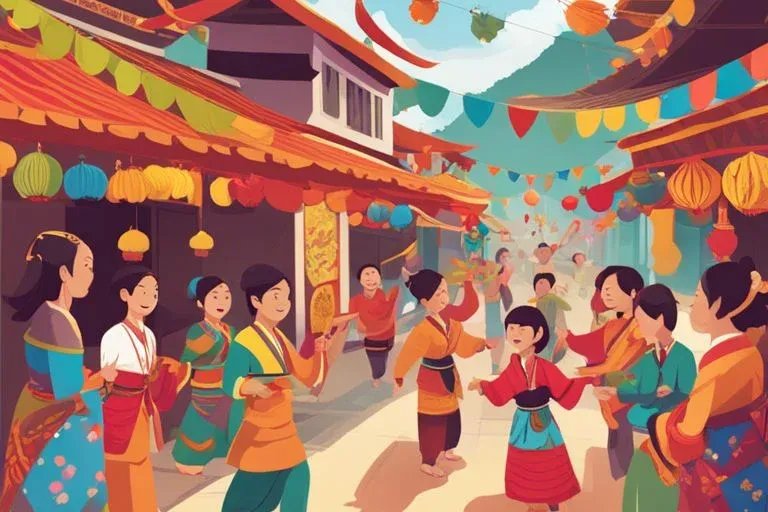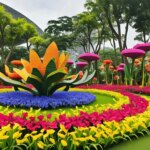Discover the rich and diverse tapestry of Malaysian traditions, which reflect the country’s multicultural heritage and customs.
From traditional dances that showcase the colorful traditions of various ethnic groups to festive foods that are bursting with unique flavors and spices, Malaysian traditions offer a glimpse into the vibrant cultural landscape of the country.
Explore the exquisite handicrafts and ethnic costumes that are deeply rooted in the customs of the Malaysian people, and learn about the customary games that have been passed down through generations.
Key Takeaways:
- Multicultural Heritage: Malaysian traditions are a reflection of the country’s multicultural society, with influences from Malay, Chinese, Indian, and indigenous cultures.
- Traditional Dances: Malaysian traditional dances such as the “Joget” and “Mak Yong” showcase diverse cultural influences and are often performed during festive occasions and cultural events.
- Festive Foods: Malaysian traditions include a wide variety of festive foods such as “nasi lemak,” “roti canai,” and “satay,” which are enjoyed during celebrations and special occasions.
Traditional Dances in Malaysia
Assuming the role of a melting pot of different cultures, Malaysia boasts a rich tapestry of traditional dances that reflect the country’s multicultural heritage. These dances are an integral part of Malaysian culture, often performed at festive occasions and special events.
Malay Classical Dances
Malaysia is home to a variety of classical Malay dances, with each having its unique style and significance. These traditional dances often tell stories of love, bravery, and heroism through graceful movements and intricate costumes. Some well-known examples include the graceful Joget, the refined Inang, and the dramatic Mak Inang.
Indigenous Dance Forms of East Malaysia
To delve into the indigenous dance forms of East Malaysia is to explore a vibrant world of cultural expression.
The various indigenous communities of Sabah and Sarawak have their distinctive dances, often accompanied by lively music and colorful traditional costumes. These dances are deeply rooted in the customs and rituals of the indigenous peoples, reflecting their connection to the land and their spiritual beliefs.
Dances such as the Sumazau of the Kadazan-Dusun people and the Ngajat of the Iban community are just a few examples of the rich diversity of indigenous dance forms in East Malaysia, showcasing the region’s multicultural heritage and traditional customs.
Chinese and Indian Dance Influences
East Malaysia has also been influenced by the traditional dance forms of its Chinese and Indian communities. The colorful and vibrant Chinese lion and dragon dances are often performed during festive celebrations, adding an air of excitement and joy to the atmosphere.
On the other hand, Indian dance forms such as Bharatanatyam and Odissi have also left their mark, with their intricate footwork and expressive movements.
These classical dance forms have become an integral part of Malaysia’s multicultural heritage, adding a layer of diversity and richness to the country’s traditional dances.
Festive Foods Across Malaysian Celebrations
Despite Malaysia’s diverse culture, one common thread that binds all its inhabitants together is their love for food. Festive foods play a crucial role in Malaysian celebrations, serving as a unifying factor across different ethnicities and traditions. From the bustling streets of Kuala Lumpur to the serene villages of Sabah, food takes center stage in every Malaysian festivity.
Local Delicacies During Major Festivals
Celebrations in Malaysia are incomplete without feasting on the array of local delicacies that are synonymous with each major festival. During Hari Raya, the Malay community prepares an assortment of delectable dishes such as rendang, ketupat, and lemang. Similarly, Chinese New Year is marked by the tradition of enjoying yee sang, tang yuan, and nian gao, which symbolize good luck and prosperity.
Meanwhile, the Indian community celebrates Deepavali with a spread of mouth-watering treats like murukku, laddu, and payasam. These festive foods not only satisfy the taste buds but also hold deep cultural significance, enhancing the richness of Malaysian traditions.
The Role of Food in Preserving Cultural Identity
Major Malaysian festivals serve as a platform for preserving the country’s cultural identity through food. Each dish is a testament to the unique customs and practices of the various ethnic groups, showcasing centuries-old traditions that have been passed down through generations. Festive foods, such as the iconic satay, kuih-muih, and nasi lemak, are more than just culinary delights, they embody the spirit of unity and pride in Malaysia’s multicultural heritage.
Through the preparation and consumption of these traditional delicacies, Malaysians continue to honor their roots and uphold the customs that define them as a nation.
Cultural heritage, traditional recipes, and ethnic cuisines are integral components that shape the country’s festive foods and reinforce the importance of preserving Malaysia’s diverse identity.
Festive foods across Malaysian celebrations reflect the multicultural heritage of the nation, embodying centuries-old customs and practices that have been passed down through generations.
Malaysian Handicrafts and Artisanal Mastery
Your journey into the exquisite world of Malaysian handicrafts and artisanal mastery is a testament to the rich cultural heritage of the country. The meticulous attention to detail and the skilled craftsmanship of Malaysian artisans have produced a wide array of stunning handcrafted products that reflect the diversity of the nation’s traditions and customs.
Textiles and Weaving Practices
Textiles play a significant role in Malaysian culture, with traditional weaving practices being an essential part of the country’s heritage. The intricate patterns and vibrant colors of Malaysian textiles, such as batik and Songket, are a testament to the exquisite artistry of the weavers.
These textiles often depict motifs inspired by nature, folklore, and mythology, showcasing the depth of cultural significance embedded in each handwoven masterpiece.
Pottery, Woodwork, and Metal Crafts
Pottery, woodwork, and metal crafts are integral to Malaysian artisanal mastery, with each medium showcasing the exceptional skills of local craftsmen. Pottery in Malaysia encompasses a diverse range of techniques, such as hand-modeling and wheel-throwing, resulting in an array of exquisite clay pots, vases, and ceremonial objects.
Woodwork and metal crafts boast intricate carvings and delicate designs, reflecting the mastery of Malaysian artisans in transforming raw materials into stunning works of art.
To delve deeper into the world of Malaysian pottery, woodwork, and metal crafts is to discover the age-old traditions that have been passed down through generations. These crafts hold a significant place in Malaysian culture, serving as both functional objects and symbolic representations of the country’s rich heritage.

Ethnic Costumes and Their Significance
Not only do Malaysian traditional costumes showcase the country’s rich cultural diversity, they also hold great significance in representing the heritage and identity of each ethnic group. These costumes are more than just clothing; they are a symbol of pride, tradition, and cultural heritage.
The Variety of Traditional Attires
The ethnic costumes of Malaysia are as diverse as the country itself, reflecting the unique customs and beliefs of each community. Their intricate designs and vibrant colors are a testament to the skilled craftsmanship and attention to detail that has been passed down through generations.
From the stunning saris worn by the Indian community to the elaborate Baju Kurung donned by the Malay women, each attire is a reflection of the history and values of its respective culture.
Symbolism and Cultural Expressions in Costumes
The ethnic costumes of Malaysia are not just aesthetically pleasing, they also carry deep cultural meanings and symbolism. The motifs and patterns on the fabrics often depict stories from folklore, traditional beliefs, and nature.
The intricate embroidery and beadwork of the costumes are a form of artistic expression, showcasing the creativity and artistry of the Malaysian people. The costumes also play a significant role in traditional ceremonies and rituals, signifying the importance of customs and traditions in the lives of the people.
For instance, the use of specific colors and textiles in the costumes represents different stages of life, such as marriage or mourning. This attention to detail and symbolism demonstrates the profound connection between the people and their cultural heritage, making Malaysian ethnic costumes an integral part of the country’s identity.
Customary Games and Recreational Activities
Unlike modern forms of entertainment, Malaysian customary games and recreational activities hold a special place in the country’s cultural heritage. These traditional games and pastimes have been passed down through generations and continue to be enjoyed by both young and old.
Indoor Games and Childhood Pastimes
An integral part of Malaysian culture, indoor games, and childhood pastimes reflect the creativity and ingenuity of the people. Ranging from the strategic game of congkak to the intricate art of weaving ketupat, these activities are not only a source of entertainment but also a means of preserving tradition and fostering family bonding.
Outdoor Games and Community Engagement
Any exploration of Malaysian traditions would be incomplete without a mention of the outdoor games and community engagement activities. These games, such as Sepak Takraw and kite-flying, not only serve as recreational pursuits but also bring people together, promoting unity and camaraderie within the community. This aspect of cultural engagement highlights the significance of traditional games in fostering a sense of belonging and identity.
This subsection delves into the unique and captivating outdoor games and recreational activities that have been cherished for centuries in Malaysian society. These activities are a testament to the rich multicultural heritage and vibrant traditions of the nation.
Conclusion
Presently, Malaysian traditions are a vibrant reflection of the country’s multicultural heritage, featuring a rich tapestry of traditional dances, festive foods, handicrafts, ethnic costumes, and customary games.
These traditions not only showcase the diversity of Malaysia’s various ethnic groups but also serve as a way to preserve and celebrate the unique cultural identities that make up the nation.
Whether it’s the intricate movements of traditional dance, the tantalizing flavors of festive foods, or the skillful craftsmanship of handicrafts, Malaysian traditions continue to be an integral part of the country’s cultural landscape, captivating both locals and visitors alike.



